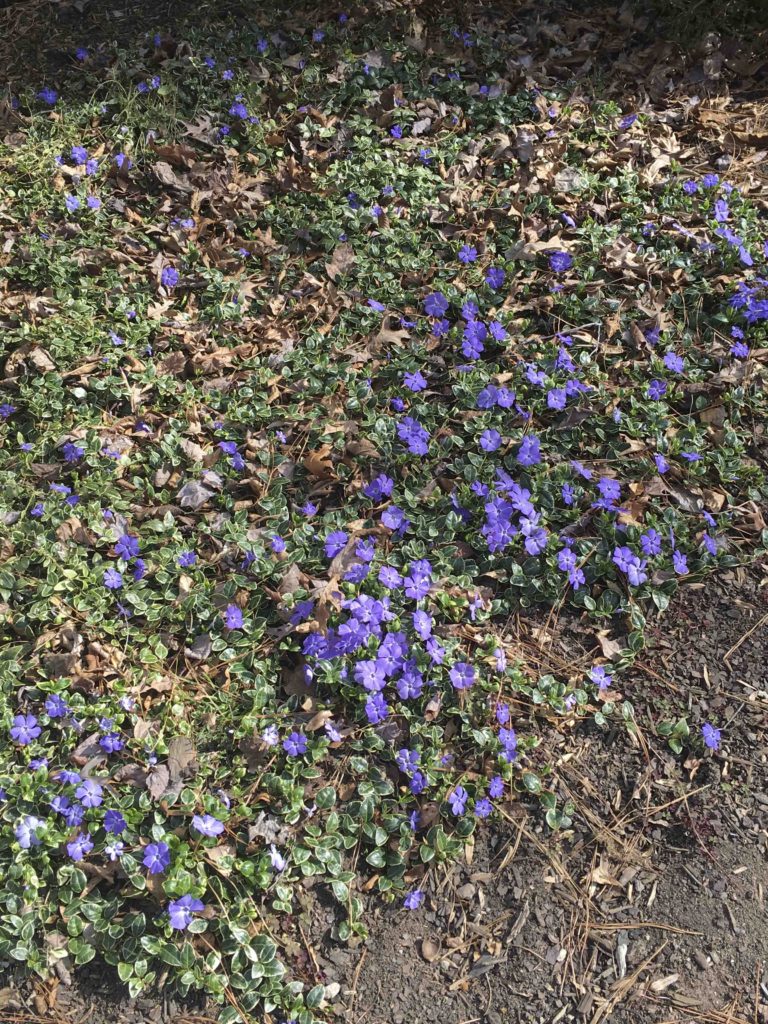By Andrea Laine, TLC member and volunteer
A version of this article was previously published on the Durham County Master Gardener blog (https://durhammastergardeners.wordpress.com).
A garden writer whose work I admire advised me to write about my gardening mistakes. Well, my biggest mistake (of late) was planting an invasive species in my landscape. In my defense, I did not know that Vinca minor (common periwinkle) was invasive in Durham County, N.C. In fact, at the time I put three small sprigs of it in the ground in front of my house, I wasn’t all that aware of what “invasive” meant in the plant world.
The North Carolina Botanical Garden defines invasive species as “plants that are not native to the southeastern United States and that have become aggressive invaders of natural areas. ”
I chose this particular ground cover because it was familiar to me. I grew it when I lived on Long Island and in suburban Philadelphia. As a bonus, my husband recalled it being a favorite of his mother’s. With variegated evergreen foliage and dainty blue flowers that bloom in the spring and sporadically through the summer – what’s not to like?
The plants have been in place for five years now and have expanded rapidly by means of arching runners which root at the tip. I don’t recall precisely when I became aware of its invasive status, but safe to say it was at least three years ago. And yet, I let them be. Why? I think I was experiencing the five stages of garden grief!
1) Denial – I refuse to believe it is an invasive plant – It is common; sold in nurseries everywhere.
2) Anger – So, what if it’s invasive! It’s attractive and serves a good purpose. Erosion in this spot is not nearly the problem it once was.
3) Bargaining – Dear Mother Nature, I promise not to plant any more of it if you agree to be okay with me having this little patch. Pretty please?
4) Depression – Okay, this stuff is beginning to act like a bully. It has expanded in every direction and I need to constantly trim it to keep it from suffocating the plants around it.
5) Acceptance – Sigh.
Generally speaking, having a relatively small patch of an invasive ornamental in your garden will not do major harm. If it is at risk of escaping into a natural area, however, it can eventually wreak havoc on the local ecosystem by edging out native species which feed native insects, birds and animals.
Vinca minor’s bully behavior alone was not enough to spring me into the acceptance stage. What really changed my mind was reading Bringing Nature Home by Douglas W. Tallamy.
Tallamy writes, “Typically it takes decades for the population of the escapees to build to the point where we start to notice that they have spread from the spots where we originally planted them (Hobbs & Humphries 1995).”
I have observed this at a friend’s property in the Virginia Piedmont region. Vinca minor was planted in the side yard of my friend’s mountain home in the late 1980s. It was a small patch then. Today, it is everywhere – it covers the back yard, the front yard, the other side of the house, across the driveway and up the hillside, down into the woods. It easily covers an acre of natural area and possibly more.
Similarly a single Euonymus alata (winged burning bush) planted on the same property decades ago has also overstayed its welcome. For years it was enjoyed – a deciduous shrub with spectacular fall foliage. Fast-forward to today and it is most unloved. The shrub reproduces vigorously underground by the root system pushing out suckers. There are scores of them on a wooded hillside acres large that was once abundant with native raspberry bushes. The competition is visible and the raspberries (which we love to eat) are losing ground.
The best way to avoid invasive plant problems is prevention. The best method for controlling invasive plants is early detection followed by a rapid response.
It is unlikely that I will be living in my home another 30 years, but the introduction of an invasive species to the natural woods around my house is not the legacy I’d like to leave in Durham. I am digging up my vinca minor.
Resources
Tallamy, D.W. (2007). Bringing nature home: how you can sustain wildlife with native plants. Portland, OR: timber Press.
About ground covers:
http://www.clemson.edu/extension/hgic/plants/landscape/groundcovers/hgic1100.html
Vinca minor invasive profile:
https://www.nps.gov/plants/alien/pubs/midatlantic/vimi.htm
Euonymous alata invasive profile:
Swearingen, J., C. Bargeron. 2016 Invasive Plant Atlas of the United States. University of Georgia Center for Invasive Species and Ecosystem Health. http://www.invasiveplantatlas.org/
Controlling Invasive Plants – a booklet from NC Botanical Garden:
http://ncbg.unc.edu/uploads/files/ControllingBooklet.pdf
More resources from the NC Botanical Garden:
http://ncbg.unc.edu/invasive-plants-resources/
National Invasive Species Information Center

